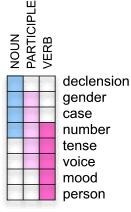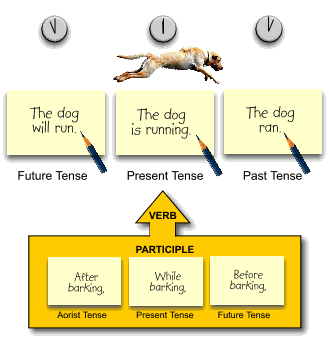Participles are words that have features both of nouns and verbs. In the illustration below, the features of all three are listed, showing the shared features.

![]()
In some ways, the participle is merely a mixed form of the noun and the verb,
either adding a verb-like element to a noun or a noun-like element to a verb,
depending on its use in the sentence. It has no distinctive feature not shared
either with the nouns or the verbs.
TENSE OF THE PARTICIPLE:
The tense of the participle is determined, not in relation of the speaker's
or writer's time to the time of the action, but in relation to the time of
the main verb. Once that is understood, everything falls into place, requiring
the following tenses of participles:
- aorist (when action of participle is before the action of verb)
- present (when action of participle is at the time of the action of verb)
- future (when action of participle is after the action of the verb).
When the tense of the verb changes, no change happens to the tense of the participle. That is to say, an action that happens before the verb will always use the aorist participle, whether the verb is past, present or future, etc.
In the illustration below, think of the tense of the participle fixed on the dark yellow card with the arrow. No matter where you move the card so the arrow points to the appropriate of the verb, the tenses required of the participle remain unaffected.




